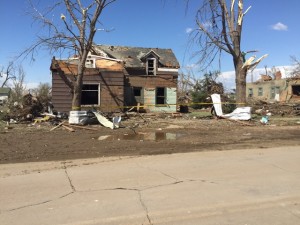ELCA Advocacy
Lutherans are taking action across the country! Below you will find our monthly State Advocacy Newsletter. Share with your friends!
Washington, D.C.
Advocacy Director, Stacy Martin
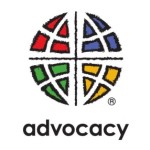 Vatican Encyclical “Laudato Si”: On June 18 Vatican officials released “Laudato Si,” an encyclical letter on caring for creation. In the encyclical, Pope Francis I places a special emphasis on our moral obligation to address the growing threats to our world caused by climate change. Arriving shortly before the upcoming global climate summit in Paris, the pope’s encyclical affirms that climate change is largely a man-made dilemma, and is a principal challenge facing humanity today. Immediately after its release, ELCA Presiding Bishop Elizabeth Eaton, praised the encyclical noting parallels to our own social statement “Caring for Creation.” Bishop Eaton also called for action to help less-privileged nations that must now face the most brutal effects of climate change.
Vatican Encyclical “Laudato Si”: On June 18 Vatican officials released “Laudato Si,” an encyclical letter on caring for creation. In the encyclical, Pope Francis I places a special emphasis on our moral obligation to address the growing threats to our world caused by climate change. Arriving shortly before the upcoming global climate summit in Paris, the pope’s encyclical affirms that climate change is largely a man-made dilemma, and is a principal challenge facing humanity today. Immediately after its release, ELCA Presiding Bishop Elizabeth Eaton, praised the encyclical noting parallels to our own social statement “Caring for Creation.” Bishop Eaton also called for action to help less-privileged nations that must now face the most brutal effects of climate change.
Smarter Sentencing Act: ELCA Advocacy took action earlier this month to support The Smarter Sentencing Act, now in the U.S. Senate Judiciary Committee, as part of our ongoing effort to address mass incarceration and racial justice in our communities. The bipartisan Smarter Sentencing Act makes modest reforms to our justice system by alleviating overcrowding in our prisons, restoring the ability of federal judges to determine fairer and more realistic sentences, and creating more transparency about how federal laws and regulations are applied. You can take action now at the ELCA Action Center.
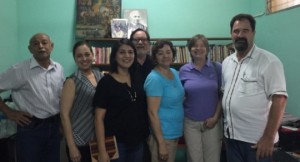 Mexico and Central America: This month, members of ELCA Advocacy and the churchwide organization staff traveled to Mexico to learn about the detainment and treatment of migrant children and families from Central America. Staff met with civil society leaders and government officials to learn more about the ongoing crisis.This visit came in the wake of the Obama administration’s ongoing foreign policy discussion that continues to focus on encouraging increased border security measures by the Mexican and Central American governments without acknowledging the immediate need to protect migrants who are forced to flee. ELCA Advocacy continues to urge lawmakers to support the protection and human rights of all God’s children and will be releasing a full report on the findings in Mexico within the coming weeks.
Mexico and Central America: This month, members of ELCA Advocacy and the churchwide organization staff traveled to Mexico to learn about the detainment and treatment of migrant children and families from Central America. Staff met with civil society leaders and government officials to learn more about the ongoing crisis.This visit came in the wake of the Obama administration’s ongoing foreign policy discussion that continues to focus on encouraging increased border security measures by the Mexican and Central American governments without acknowledging the immediate need to protect migrants who are forced to flee. ELCA Advocacy continues to urge lawmakers to support the protection and human rights of all God’s children and will be releasing a full report on the findings in Mexico within the coming weeks.
Mother Emanuel AME in Charleston, S.C.: Presiding Bishop Eaton and leaders of the ELCA offered their prayers to the victims of the Mother Emanuel AME tragedy earlier this month. Two of the victims, including the Rev. Clementa Pinckney, were graduates of the Lutheran Theological Southern Seminary, an ELCA seminary in Columbia, S.C. Bishop Eaton, who later attended Pinckey’s funeral, reaffirmed in a statement the immediate urgency to address racism as a society and as a church. ELCA Advocacy recognizes that we cannot truly seek justice and peace through advocacy without being committed to ending racism. We commit ourselves to working toward this goal and ask that you join us in this effort. Follow our Advocacy efforts and ELCA Racial Justice Ministries to learn how you can join in the conversation.
 The Endangered Species Act: On June 25, ELCA Environmental Policy Director Mary Minette was on a panel of experts about our moral obligation to care for creation by protecting endangered species. The event was attended by Senate and coalition-partner staff. In her message, Mary reaffirmed our religious calling to be stewards of nature by caring for creatures and the environments around them. To protect God’s creation, we must make environment-friendly choices as well as advocate for continuing the Endangered Species Act, which is, as Mary put it, “a modern-day Noah’s ark.”
The Endangered Species Act: On June 25, ELCA Environmental Policy Director Mary Minette was on a panel of experts about our moral obligation to care for creation by protecting endangered species. The event was attended by Senate and coalition-partner staff. In her message, Mary reaffirmed our religious calling to be stewards of nature by caring for creatures and the environments around them. To protect God’s creation, we must make environment-friendly choices as well as advocate for continuing the Endangered Species Act, which is, as Mary put it, “a modern-day Noah’s ark.”
____________________
New York, NY
Dennis Frado, Lutheran Office for World Community
Ministerium meeting at LOWC: On May 12, LOWC welcomed the Lutheran pastors from Manhattan to the Church Center for the United Nations. The meeting of the ELCA Manhattan Ministerium Conference started with worship on social justice under the heading “Sing a new song to the Lord.” Afterward the ministers had an opportunity to learn about the work of the Lutheran office and discussed possible areas of cooperation. The LOWC staff also expressed their offer to visit congregations that are interested in our work to the United Nations.
Peace Not Walls gathering: About 30 members of the Peace Not Walls network gathered in mid-June at Trinity Lutheran Seminary in Columbus, Ohio to discuss recent activities and future work plans. They shared ideas for synod engagement, heard reports on advocacy activities, proposed teleconferences with speakers from the Holy Land, heard updates about future young adult trips to the region, discussed the intersections of work between Peace Not Walls and racial justice and received an update about staff efforts to explore “positive investment” in connection with the 2013 Churchwide Assembly request.
Lutheran World Federation Council meeting: As has become the custom, Dennis Frado served as co-opted staff for several of the committees of the annual meeting of the Lutheran World Federation Council when it met last month in Chavannes-de-Bogis, near Geneva, Switzerland. The council adopted four public statements and four resolutions. The public statements were on climate justice, protracted conflicts and over-stretched humanitarian response, the situation in Tanah Papua (West Papua, Indonesia) and the sin of racism (in response to the shooting in South Carolina). The four resolutionscovered the Middle East, Migrants, the post-2015 Development Agenda and the recent Nigeria elections.
Unaccompanied and migrant children consultation: Following a number of conversations with synodical bishops, the ELCA Church Council and others, the churchwide organization called together a consultation last month to provide input for a proposed churchwide unaccompanied and migrant children initiative. Dennis is serving on the writing team to prepare the document related to the initiative with Alaide Vilchis Ibarra of the ELCA Advocacy office and Megan Brandsrud, program interpreter for Lutheran Disaster Response. It is expected to be reviewed by the Conference of Bishops later this year and be considered by the Church Council at one of its future meetings.
____________________
California
Mark Carlson, Lutheran Office of Public Policy
Sadness about Emanuel AME is mixed with good feelings about a state budget that includes a new state Earned Income Tax Credit, over $300 million in new funding for preschool and child care, health insurance coverage for undocumented children, resources to assist immigrant integration into society, and money for access to scarce water in disadvantaged communities as the drought worsens. There is good news about housing, as the first grants of carbon cap-and-trade funds were announced under the Affordable Homes and Sustainable Communities program, with more to come. LOPP-CA was part of the collective effort needed to achieve this progress.
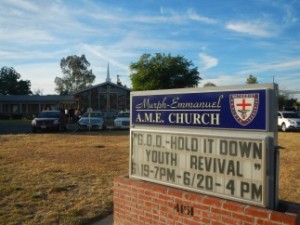 On Friday following the Charleston massacre, LOPP-CA Director Mark Carlson attended a prayer service at Murph-Emmanuel AME (site of a former ELCA congregation) and left Bishop Eaton’s statement and spoke with the pastor of St. Andrew’s AME, the oldest AME church west of the Mississippi.
On Friday following the Charleston massacre, LOPP-CA Director Mark Carlson attended a prayer service at Murph-Emmanuel AME (site of a former ELCA congregation) and left Bishop Eaton’s statement and spoke with the pastor of St. Andrew’s AME, the oldest AME church west of the Mississippi.
On his own time, Mark went with family to see “Inside Out,” a “a major emotion picture,”the Pixar-animated tale of Riley Anderson, age 11, who moves from Minnesota, where her “core memories” were made, with her parents to more diverse “San Franstinktown.” Joy, Sadness, Anger, Fear, and Disgust live in her head. She is engaged with Islands of Friendship, Family, and Honesty, among others, which crumble as she and her family try to adapt to a new life. Joy and Sadness work in grace for renewal, including a new Island of Friendly Argumentation, what we might call “moral deliberation.”
____________________
Colorado
Peter Severson, Lutheran Advocacy Ministry – Colorado
Self-Sufficiency Standard: The Colorado Center on Law & Policy recently released the 2015 Colorado Self-Sufficiency Standard, a measure of how expensive it is to live in Colorado. Lutheran Advocacy Ministry-Colorado was present at the launch event alongside many other interest groups. The standard calculates the income required for a family to meet basic needs without assistance. On average, costs increased by 32 percent across Colorado between 2001 and 2015. While the amount needed to be self-sufficient varies considerably by geography, 7 out of 10 of the most common occupations in Colorado pay median wages below the standard. Closing that gap will require both reducing costs and raising incomes, both of which will be part of LAM-CO’s economic policy agenda for the 2016 legislative session.
Other events: LAM-CO Director Peter Severson was invited to give the benediction at the graduation of the Family Leadership Training Institute, a civic engagement program run by the Department of Public Health. Severson shared the stage with more than 100 graduates as well as Secretary of State Wayne Williams. Severson also recently attended the Colorado Consumer Health Initiative annual summit, took part in the commissioning of summer staff at Sky Ranch Lutheran Camp, and participated in Together Colorado’s summit of Denver faith leaders at Shorter Community AME Church.
____________________
Minnesota
Tammy Walhoff, Lutheran Advocacy – Minnesota
tammy@lcppm.org
The legislative special session: Gov. Mark Dayton had been cut out of negotiation processes through much of the session and vetoed three funding bills, necessitating a special session. A month of negotiations finally reached adequate agreement to call the special session, though even then it was not a smooth process. LA-MN’s priority issues saw little change, although both housing and clean energy were in a vetoed bill.
Homes for all priorities (final): The coalition, supported by grassroots action, secured a $25.5 million boost for housing and homeless services (including $10 million in bonds for housing). Homeless Youth programing increased $1 million per year. New funds will help thousands of Minnesotans access safe, stable and affordable housing. (For funding table, click here, and find the full bill here.)
Clean energy (final): There were no improvements to the Renewable Energy Standard or energy efficiency (original goal). Success became stopping roll-backs taking Minnesota significantly backward. The faith leader letter (see May update) played a significant role in that regard.
Papal encyclical: LA-MN used news of the new encyclical to draw attention to the ELCA social statement on the care of creation. Plans are to use the encyclical for study, to emphasize our stewardship role, and to tie poverty to climate and environmental degradation.
Synod-related activities: LA-MN Director Tammy Walhof led a workshop on housing, homeless youth and advocacy at the Southwestern Minnesota Synod.
Continuing education: A theological retreat with colleagues, focused on Dietrich Bonhoeffer’s “Ethics,” made for interesting reflection in the advocacy context.
Twitter: @LuthAdvocacyMN Facebook
____________________
New Mexico
Ruth Hoffman, Lutheran Advocacy Ministry – New Mexico
 Learning about advocacy ministry: Youth from Peace and Trinity Lutheran churches in Las Cruces stopped at the Roundhouse, as the New Mexico state Capitol is nicknamed, on their “mystery trip.” LAM-NM Director Ruth Hoffman spoke to the group about advocacy ministry in a legislative committee room where they were able to sit in the legislators’ chairs and learn about how to be involved in advocacy. Ruth also took them on a tour of the Capitol. Thanks to Laura Carson, AIM and the Christian education and youth ministry director at Peace Lutheran for inviting LAM-NM to be a part of the adventure.
Learning about advocacy ministry: Youth from Peace and Trinity Lutheran churches in Las Cruces stopped at the Roundhouse, as the New Mexico state Capitol is nicknamed, on their “mystery trip.” LAM-NM Director Ruth Hoffman spoke to the group about advocacy ministry in a legislative committee room where they were able to sit in the legislators’ chairs and learn about how to be involved in advocacy. Ruth also took them on a tour of the Capitol. Thanks to Laura Carson, AIM and the Christian education and youth ministry director at Peace Lutheran for inviting LAM-NM to be a part of the adventure.
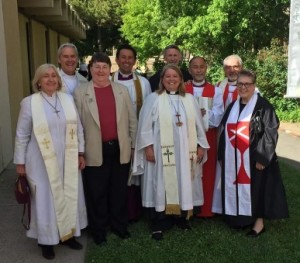 Ecumenical connections: Rocky Mountain Synod Bishop Jim Gonia and LAM-NM Director Ruth Hoffman were part of the ecumenical and interfaith attendees at the installation of the new archbishop of Santa Fe. The Most Rev. John C. Wester comes to the archdiocese from Salt Lake City where he served as bishop and worked in partnership with local ELCA pastors on issues of immigration and poverty. Utah is within the territory of the Rocky Mountain Synod so we look forward to continuing our partnership with Archbishop Wester.
Ecumenical connections: Rocky Mountain Synod Bishop Jim Gonia and LAM-NM Director Ruth Hoffman were part of the ecumenical and interfaith attendees at the installation of the new archbishop of Santa Fe. The Most Rev. John C. Wester comes to the archdiocese from Salt Lake City where he served as bishop and worked in partnership with local ELCA pastors on issues of immigration and poverty. Utah is within the territory of the Rocky Mountain Synod so we look forward to continuing our partnership with Archbishop Wester.
____________________
Ohio
Nick Bates, The Faith Coalition for the Common Good
Gov. John Kasich signed the Ohio budget on Tuesday, June 30. Faith advocates are pleased that the conference committee restored Medicaid services for pregnant women up to 200 percent of the poverty level, removed a last minute amendment that would have cut homeless and affordable housing programs in half, and increased funding for emergency food banks. Faith advocates in Ohio will continue to advocate for increased access to emergency cash assistance, more equitable school funding, and a more progressive state tax system – including a refundable Earned Income Tax Credit to help lift Ohio families out of poverty. For more information, please contact Nick Bates at batesyep@gmail.com.
____________________
Pennsylvania
Amy Reumann, Lutheran Advocacy Ministry in Pennsylvania
Tracey DePasquale, Associate Director
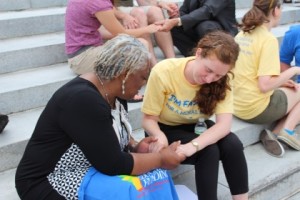 As the July 1 budget deadline looms without promise of being met, Lutheran advocates are making their voices heard in the Capitol.
As the July 1 budget deadline looms without promise of being met, Lutheran advocates are making their voices heard in the Capitol.
LAMPa led a prayer service on the Capitol steps June 23 in conjunction with a rally by the Campaign for Fair Education Funding and a faith-based organizing fast. Lutherans from around the state joined in the day of advocacy. The Rev. Carlton Rodgers, Philadelphia, preached on the Capitol steps. 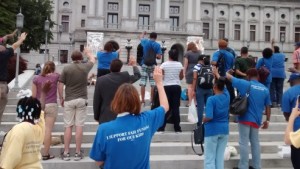 Read his stirring sermon. The Rev. David Byerly, Shamokin, a LAMPa policy council member, spoke at the press conference. Both called for an end to the injustice of the state’s record of being the worst in the nation for school funding equity.
Read his stirring sermon. The Rev. David Byerly, Shamokin, a LAMPa policy council member, spoke at the press conference. Both called for an end to the injustice of the state’s record of being the worst in the nation for school funding equity.
The LAMPa network responded quickly to help stall a bill that would have created a lifetime ban for those with felony drug offenses from receiving nutrition benefits. Lutheran advocates have also been active in alerting lawmakers against supporting another bill that would legalize payday lending.
LAMPa submitted testimony in support of the death penalty moratorium and assisted in publishing a letter from the state’s seven bishops in support of legislation to prohibit discrimination in areas of employment, housing and public accommodation on the basis of actual or perceived sexual orientation and gender identity or expression. Staff attended seven assemblies, which included advocacy-related resolutions on hunger, non-discrimination and the environment.
LAMPa also equipped confirmation campers for their calling to strive for justice and a trip to Washington, D.C., where they advocated for clean water and child nutrition.
____________________
Virginia
Charles Swadley
Virginia Interfaith Center for Public Policy
On June 30, VICPP’s Virginia Consumer Voices for Healthcare program held a highly successful event, “Healthcare Access as a Moral Imperative,” which was co-organized by VICPP’s Richmond Chapter. Donations were generated for the Health Wagon, which provides remote-area medical services in Virginia and has been featured on “60 Minutes.” A capacity crowd of more than 150 was called into action for affordable health care access and expansion in Virginia! We are now planning to replicate this event with the two nurses of “60 Minutes” fame in Hampton Roads, Northern VA and Roanoke in the months ahead!
On June 18, Virginia Interfaith Center members joined people of all faiths at a prayer vigil at Second Baptist Church to trump fears and setbacks associated with the Charleston murders the previous day. Those assembled are organizing for unity and faith in action about the chronic issue and the solutions for hate crimes.
VICCP joined the Virginia Council of Churches in developing Virginia’s interfaith condemnation of the murders in Charleston.
Members of VICPP’s New River Valley Chapter joined members of the NAACP, Common Cause, and League of Women Voters in a Voting Rights Act rally in Roanoke on June 25. VICPP is joining with the Center for American Progress to produce an Anti-Poverty Summit to be held in the fall in Hampton Roads. VICPP is helping to lead a statewide anti-hunger effort with faith communities and partners, including the ELCA, the Office of the First Lady and the Virginia Poverty Law Center.
____________________
Washington
Paul Benz, Faith Action Network
Policy: The state Legislature, after three special sessions, finally got the 2015-2017 biennial operating budget approved and signed by the governor just before midnight on June 30 – the last of day of the current biennium. The $38.2 billion operating budget (capital and transportation budgets were approved separately on the same night) raised only $185 million in new revenue by eliminating two tax exemptions (Washington state has 600). Funding for the K-12 public school system is under a state Supreme Court order – we await the court’s response as to whether this portion of the budget is adequate to fund education. The state education secretary is adamant that it’s not enough and does little to change the unfair levy funding system.
One key policy/revenue-related bill that passed allows counties (by a vote of the people) to raise one-tenth of 1 percent in local sales tax dedicated to housing and mental health services.
On the congressional front, our four primary issues are: trade (Trans-Pacific Partnership), Child Nutrition Reauthorization (summer hunger bills), Green Climate Fund, and the International Violence Against Women Act. FAN’s goal is to meet with all 12 members of our congressional delegation. A FAN delegation had our first meeting on July 1 with Rep. Derek Kilmer, and later this month we’ll meet with Sen. Maria Cantwell.
Organizing and programs: FAN’s Network of Advocating Faith Communities reached a milestone with our 100th faith community joining: Three Rivers Unitarian Universalists in eastern Washington. Our outreach continues with the Muslim community by attending the beginning of Ramadan in an eastern Washington mosque and an interfaith Iftar dinner in a Seattle-area mosque. FAN also released its statement on the Charleston murders and signed on to the Statewide Ecumenical Executives statement. FAN is in its third program season of the year, which is the convening of our Network of Advocating Faith Communities by 17 geographic clusters around the state. The purpose is to deepen relationships among local faith communities and strengthen our joint advocacy efforts. We’re beginning to plan two fall forums on taxation and its role in building a more equitable and sustainable state. Planning is also underway for our annual dinner in November.
____________________
Wisconsin
Cindy Crane, Lutheran Office for Public Policy in Wisconsin
State budget: The Legislature will likely make final decisions about the state budget soon. We are pleased with the $2 million included in the budget to assist youth victims of sex trafficking but are disappointed in some of the deep cuts and the decision to add the requirement for drug testing for recipients of public assistance to the budget.
Other bills: The bill that would return 17-year-old non-violent offenders to the juvenile justice system will now be addressed apart from the budget. Safe Harbor, ensuring youth under 18 caught in the sex trade will be treated as victims, has officially become a bill and will likely go to committee later in the summer or fall.
Synod assemblies: LOPPW had a display table and held the following workshops at four synod assemblies:
 La Crosse Area Synod: “How to be an Advocate from a Faith Perspective,” co-led by the director and Council Member Bridget Crave.
La Crosse Area Synod: “How to be an Advocate from a Faith Perspective,” co-led by the director and Council Member Bridget Crave.
 Greater Milwaukee Synod: “Human Trafficking in our Backyard,” led by the director. The Assembly was held at Carthage College.
Greater Milwaukee Synod: “Human Trafficking in our Backyard,” led by the director. The Assembly was held at Carthage College.
Northwest Synod: “Advocacy and the Proposed State Budget,” co-led by the director and Council Member the Rev. Diane House. 
 South-Central Synod: “Poverty and our State Budget,” co-led by the director and Council Member Lisa Hassenstab.
South-Central Synod: “Poverty and our State Budget,” co-led by the director and Council Member Lisa Hassenstab.
Sermon after Charleston deaths: LOPPW’s directorpreached at St. John’s Lutheran Church in Madison on June 21.
____________________
What advocacy efforts are going on in your synod or state? We want to hear about it!


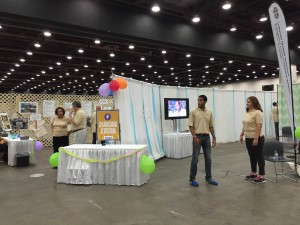
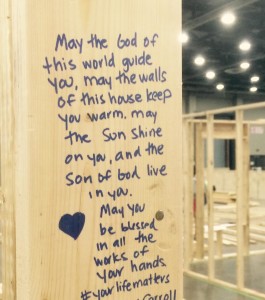



 Vatican Encyclical “Laudato Si”: On June 18 Vatican officials released “Laudato Si,” an
Vatican Encyclical “Laudato Si”: On June 18 Vatican officials released “Laudato Si,” an  Mexico and Central America: This month, members of ELCA Advocacy and the churchwide organization staff traveled to Mexico to learn about the detainment and treatment of migrant children and families from Central America. Staff met with civil society leaders and government officials to learn more about the ongoing crisis.This visit came in the wake of the Obama administration’s ongoing foreign policy discussion that continues to focus on encouraging increased border security measures by the Mexican and Central American governments without acknowledging the immediate need to protect migrants who are forced to flee. ELCA Advocacy continues to urge lawmakers to
Mexico and Central America: This month, members of ELCA Advocacy and the churchwide organization staff traveled to Mexico to learn about the detainment and treatment of migrant children and families from Central America. Staff met with civil society leaders and government officials to learn more about the ongoing crisis.This visit came in the wake of the Obama administration’s ongoing foreign policy discussion that continues to focus on encouraging increased border security measures by the Mexican and Central American governments without acknowledging the immediate need to protect migrants who are forced to flee. ELCA Advocacy continues to urge lawmakers to  The Endangered Species Act: On June 25, ELCA Environmental Policy Director Mary Minette was on a panel of experts about our moral obligation to care for creation by protecting endangered species. The event was attended by Senate and coalition-partner staff. In her message, Mary reaffirmed our religious calling to be stewards of nature by caring for creatures and the environments around them. To protect God’s creation, we must make environment-friendly choices as well as advocate for continuing the Endangered Species Act, which is, as Mary put it, “a modern-day Noah’s ark.”
The Endangered Species Act: On June 25, ELCA Environmental Policy Director Mary Minette was on a panel of experts about our moral obligation to care for creation by protecting endangered species. The event was attended by Senate and coalition-partner staff. In her message, Mary reaffirmed our religious calling to be stewards of nature by caring for creatures and the environments around them. To protect God’s creation, we must make environment-friendly choices as well as advocate for continuing the Endangered Species Act, which is, as Mary put it, “a modern-day Noah’s ark.” On Friday following the Charleston massacre, LOPP-CA Director Mark Carlson attended a prayer service at Murph-Emmanuel AME (site of a former ELCA congregation) and left Bishop Eaton’s statement and spoke with the pastor of St. Andrew’s AME, the oldest AME church west of the Mississippi.
On Friday following the Charleston massacre, LOPP-CA Director Mark Carlson attended a prayer service at Murph-Emmanuel AME (site of a former ELCA congregation) and left Bishop Eaton’s statement and spoke with the pastor of St. Andrew’s AME, the oldest AME church west of the Mississippi. Learning about advocacy ministry: Youth from Peace and Trinity Lutheran churches in Las Cruces stopped at the Roundhouse, as the New Mexico state Capitol is nicknamed, on their “mystery trip.” LAM-NM Director Ruth Hoffman spoke to the group about advocacy ministry in a legislative committee room where they were able to sit in the legislators’ chairs and learn about how to be involved in advocacy. Ruth also took them on a tour of the Capitol. Thanks to Laura Carson, AIM and the Christian education and youth ministry director at Peace Lutheran for inviting LAM-NM to be a part of the adventure.
Learning about advocacy ministry: Youth from Peace and Trinity Lutheran churches in Las Cruces stopped at the Roundhouse, as the New Mexico state Capitol is nicknamed, on their “mystery trip.” LAM-NM Director Ruth Hoffman spoke to the group about advocacy ministry in a legislative committee room where they were able to sit in the legislators’ chairs and learn about how to be involved in advocacy. Ruth also took them on a tour of the Capitol. Thanks to Laura Carson, AIM and the Christian education and youth ministry director at Peace Lutheran for inviting LAM-NM to be a part of the adventure. Ecumenical connections: Rocky Mountain Synod Bishop Jim Gonia and LAM-NM Director Ruth Hoffman were part of the ecumenical and interfaith attendees at the installation of the new archbishop of Santa Fe. The Most Rev. John C. Wester comes to the archdiocese from Salt Lake City where he served as bishop and worked in partnership with local ELCA pastors on issues of immigration and poverty. Utah is within the territory of the Rocky Mountain Synod so we look forward to continuing our partnership with Archbishop Wester.
Ecumenical connections: Rocky Mountain Synod Bishop Jim Gonia and LAM-NM Director Ruth Hoffman were part of the ecumenical and interfaith attendees at the installation of the new archbishop of Santa Fe. The Most Rev. John C. Wester comes to the archdiocese from Salt Lake City where he served as bishop and worked in partnership with local ELCA pastors on issues of immigration and poverty. Utah is within the territory of the Rocky Mountain Synod so we look forward to continuing our partnership with Archbishop Wester. As the July 1 budget deadline looms without promise of being met, Lutheran advocates are making their voices heard in the Capitol.
As the July 1 budget deadline looms without promise of being met, Lutheran advocates are making their voices heard in the Capitol.
 La Crosse Area Synod: “How to be an Advocate from a Faith Perspective,” co-led by the director and Council Member Bridget Crave.
La Crosse Area Synod: “How to be an Advocate from a Faith Perspective,” co-led by the director and Council Member Bridget Crave. Greater Milwaukee Synod: “Human Trafficking in our Backyard,” led by the director. The Assembly was held at Carthage College.
Greater Milwaukee Synod: “Human Trafficking in our Backyard,” led by the director. The Assembly was held at Carthage College.
 South-Central Synod: “Poverty and our State Budget,” co-led by the director and Council Member Lisa Hassenstab.
South-Central Synod: “Poverty and our State Budget,” co-led by the director and Council Member Lisa Hassenstab.